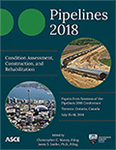Pipelines 2018
Criticality Model to Prioritize Pipeline Rehabilitation Decisions
Publication: Pipelines 2018: Condition Assessment, Construction, and Rehabilitation
ABSTRACT
Sewer networks are comprised of a huge maze of underground pipelines. They are designed and laid to transfer sewage medium to treatment plants or disposal areas. However, their conditions are subject to deterioration owing to ageing. The American Society of Civil Engineers claimed that the sewer infrastructure grade is D+. Inspection, assessment, and effective decisions are required to enhance their performance through their service life. There are several inspection methods and assessment models that can evaluate the condition of the pipelines. When evaluating the global network, the city or municipality will end up having thousands of pipeline conditions. Therefore, they confront obstacles in deciding which pipelines to tackle first. The objective of this study is to design a criticality model that is based on multiple factors that could affect the criticality of one pipeline to another. The study evaluates the weights for the environmental, economic, and public factors as well as their subfactors by using the analytic network process (ANP). The results concluded that the most important factor is the economic factor. The criticality model is implemented on an actual case study brought from the city of Edmonton, Canada. Based on the results, 20% of the pipelines are of low criticality; 70% are of medium criticality; and 10% are of high criticality. This study is expected to enhance the prioritization of the pipelines in the network for efficient future decisions.
Get full access to this article
View all available purchase options and get full access to this chapter.
REFERENCES
American Society of Civil Engineers (ASCE). (2017). “2013 Report Card for America’s Infrastructure.” <www.infrastructurereportcard.org/a/documents/2017-Report-Card.pdf> (May 16, 2017).
Baah, K., Dubey, B., Harvey, R., & McBean, E. (2015). “A risk-based approach to sanitary sewer pipe asset management.” Science of the Total Environment, 505, 1011–1017.
Bradbury, K. R., Borchardt, M. A., Gotkowitz, M., Spencer, S. K., Zhu, J., and Hunt, R. J. (2013). “Source and transport of human enteric viruses in deep municipal water supply wells.” Environmental science & technology, 47(9), 4096–4103.
Gallay, A., De Valk, H., Cournot, M., Ladeuil, B., Hemery, C., Castor, C., & Desenclos, J. C. (2006). “A large multi-pathogen waterborne community outbreak linked to faecal contamination of a groundwater system.” Clinical Microbiology and Infection, 12(6), 561–570.
Hahn, M. A., Palmer, R. N., Merrill, M. S., and Lukas, A. B. (2002). “Expert system for prioritizing the inspection of sewers: Knowledge base formulation and evaluation.” Journal of Water Resources Planning and Management, 128(2), 121–129.
Kaddoura, K. (2015). “Automated Sewer Inspection Analysis and Condition Assessment.” Msc, Concordia University, Montreal, Canada.
Kaddoura, K, Zayed, T, and Hawari, A. (2017). “Multiattribute Utility Theory Deployment in Sewer Defects Assessment.” Journal of Computing in Civil Engineering, 32(2),04017074.
Malik, O., Pumphrey, N. D., and Roberts, F. L. (1997). Sanitary sewers: State-of-the-practice. Proceedings of Infrastructure Condition Assessment: Art, Science, and Practice, ASCE, US, 297–306.
Miles, S. W., Styers, F. C., and Nesbit, C. M. (2007). “Setting Pipeline Rehabilitation Priorities to Achieve” Best” Results—A Case Study Using Condition and Criticality Criteria.” Proceedings of Pipelines 2007: Advances and Experiences with Trenchless Pipeline Projects, ASCE, US, 1–10.
Project Steering Committee (PSC). 2016. “Canadian Infrastructure Report Card: Informing the Future.”<www.canadainfrastructure.ca/downloads/Canadian_Infrastructure_Report_2016.pdf> (May 15, 2016).
Salman, B., & Salem, O. (2011). “Risk assessment of wastewater collection lines using failure models and criticality ratings.” Journal of pipeline systems engineering and practice, 3(3), 68–76.
Swamee, P. K. (2001). “Design of sewer line.” Journal of Environmental Engineering, 127(9), 776–781.
Syachrani, S., Jeong, H. D., and Chung, C. S. (2013). “Advanced criticality assessment method for sewer pipeline assets.” Water Science and Technology, 67(6), 1302–1309.
Theoharidou, M., Kotzanikolaou, P., & Gritzalis, D. (2010). “A multi-layer criticality assessment methodology based on interdependencies. Computers & Security, 29(6), 643–658.
Information & Authors
Information
Published In
Pipelines 2018: Condition Assessment, Construction, and Rehabilitation
Pages: 75 - 85
Editors: Christopher C. Macey, AECOM and Jason S. Lueke, Ph.D., Associated Engineering
ISBN (Online): 978-0-7844-8165-3
Copyright
© 2018 American Society of Civil Engineers.
History
Published online: Jul 11, 2018
Authors
Metrics & Citations
Metrics
Citations
Download citation
If you have the appropriate software installed, you can download article citation data to the citation manager of your choice. Simply select your manager software from the list below and click Download.
